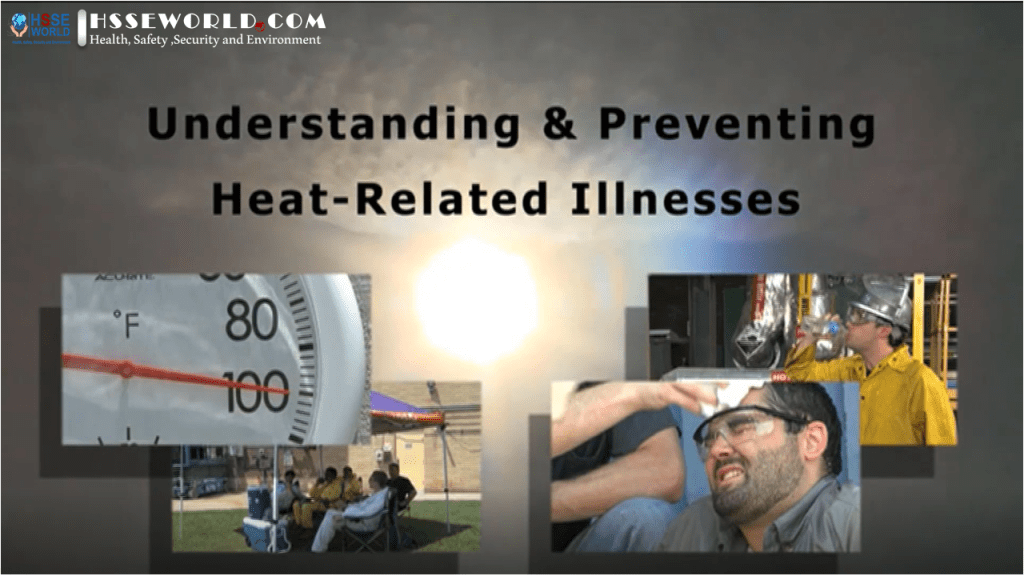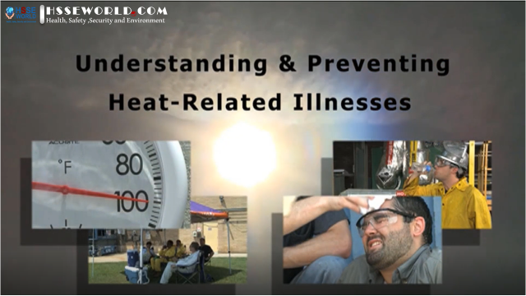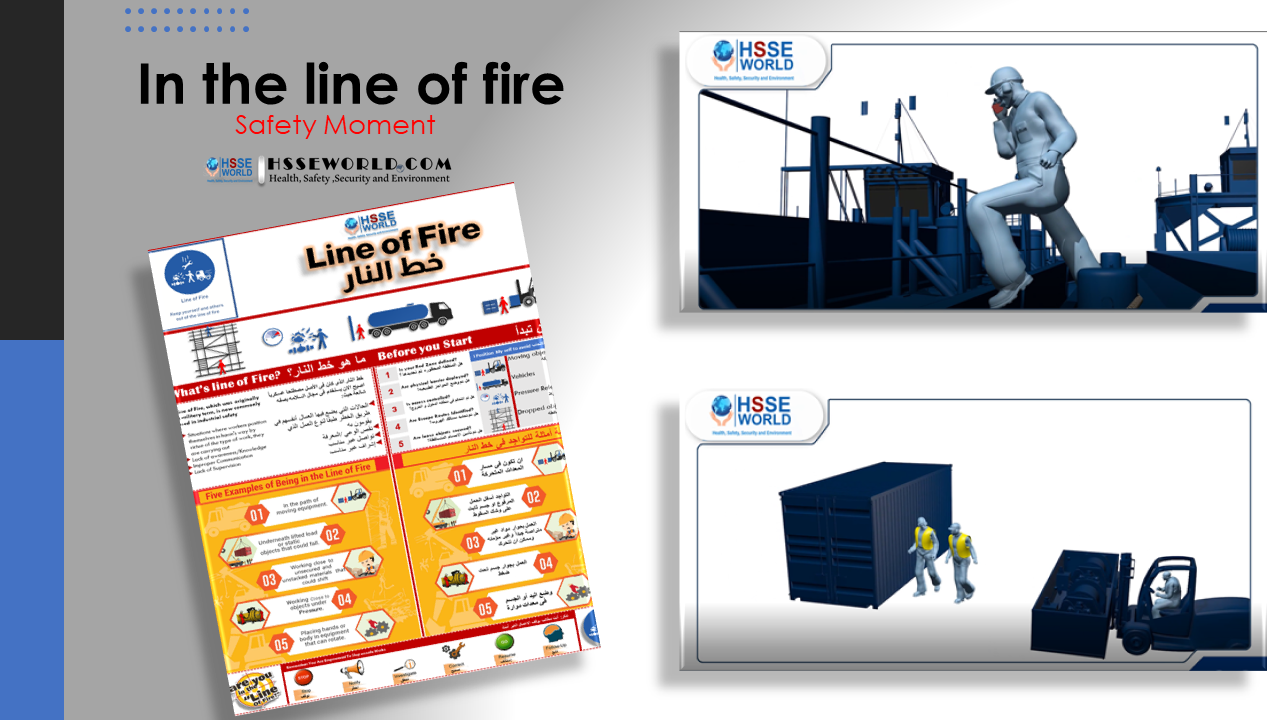As the temperature rises this summer and we continue to perform our regular job duties, the potential for heat-related illnesses increases dramatically. Collectively known as heat stress, these illnesses are serious and can even cause death in some cases. Your employees must be vigilant in their efforts to prevent them. Illnesses include heat cramps, heat rash, heat syncope, and potentially fatal heat exhaustion and heat stroke, which account for over 400 worker deaths each year.
in the video below and the following article you will learn:
- How the human body responds to hot conditions.
- What the symptoms of various heat-related illnesses are and how they should be treated.
- The process of becoming acclimated to hot environments.
- What precautions employees and companies can take to prevent heat stress such as the use of the buddy system.
- Preventing heat stress at indoor facilities.
- Specialized clothing and protective devices for working in hot conditions.
( for more learning watch the Video Below )

Background
It’s that time of year again—as spring evolves into summer, the temperatures outside are beginning to soar.
While some parts of the nation will experience warmer weather sooner than others, ultimately we all will have to deal with the heat.
As hot conditions intensify and we continue to perform our regular job duties, the potential for heat-related illnesses also rises.
Collectively known as heat stress, these illnesses include heat cramps, heat rash, heat syncope, and potentially fatal heat exhaustion and heat stroke, which account for over 400 worker deaths each year.
How the human body responds to hot conditions
- To avert the potential for heat-related illnesses, you first need to understand how heat affects our bodies and how our bodies respond to this heat.
- Our bodies naturally attempt to maintain a constant internal temperature.
- When exposed to hot conditions, excess body heat is expelled when the amount of blood circulating to the skin is increased, allowing cooling to occur. As this heat exits your body, it may cause your skin to appear flushed.
- If the increased blood flow alone cannot cool the body, your sweat glands release perspiration onto the skin. As this perspiration evaporates from the skin, heat is removed, cooling the body and preserving its temperature.
- The body can only maintain its internal temperature if this process functions properly. If the process is interrupted or cannot regulate the temperature effectively for any reason, the symptoms of heat stress will begin to appear.
- For example, if the perspiration is unable to evaporate, there is no cooling effect on the body. High humidity and increased levels of physical activity can hinder the evaporation process.
- When this occurs, the body responds by further increasing the amount of blow flowing toward the skin’s surface in a desperate attempt to cool down the body’s core temperature, leaving the brain, muscles, and other body parts with a depleted blood supply.
- This can lead to the onset of heat stress as the body experiences fatigue and diminished muscle strength. Mental faculties such as emotions, judgment, and comprehension can also be adversely affected.
Heat rash
- Heat rash, sometimes called prickly heat, can occur when perspiration stays on the skin so long that the sweat glands become clogged.
- The rash is accompanied by a hot, prickly sensation. It also reduces our tolerance to heat by limiting our ability to sweat.
- To avoid contracting heat rash, take periodic breaks in cool areas to allow sweat to evaporate and your body to cool off.
- To treat heat rash, first, allow the affected area to air dry. Then gently clean with a mild, non-deodorant soap.
- Rinse and pat dry thoroughly with a cotton towel. Avoid rubbing or irritating the skin.
Heat cramps
- Heat cramps often occur after extended periods of heat exposure combined with very heavy sweating.
- These cramps are painful muscle spasms of the abdomen, arms, and calves that result from extreme losses of water, salt, and other minerals.
- Water alone will not replenish the salt and minerals needed to prevent heat cramps. When working in hot environments with prolonged, profuse sweating, drink sports drinks or other fluids specially made to provide salt and minerals.
Heat syncope
- Heat syncope occurs when blood is directed to the skin to cool the body down and results in the lack of blood flow to the brain. This reduces or halts its function, causing fainting or severe dizziness.
- Heat syncope often occurs when a person must stand for long periods of time or rises suddenly from a sitting or lying position during hot conditions.
- In addition to fainting and dizziness, symptoms of heat syncope can include headache, increased pulse rate, nausea, fatigue, dry mouth, and vomiting.
- If you or a co-worker experiences these symptoms, it is imperative that you take action as soon as possible. Heat syncope can lead to the much more serious condition of heatstroke if ignored.
- Loosen the victim’s clothing and have him lie down in a cool place and slightly elevate his feet for about 15 minutes. If possible, fan the victim or apply a cool compress to his forehead.
- After the victim regains his composure, have him slowly drink small quantities of water, clear juice, or a sports beverage approximately every five minutes.
Heat exhaustion
- Heat exhaustion is usually brought on by intense physical exertion in hot conditions. In such environments, profuse sweating causes dehydration and loss of salt and other materials.
- Besides intense sweating, victims of heat exhaustion often experience blurred vision and rapid breathing. Their skin may be moist and cool to the touch and they usually have a weak pulse.
- The judgment of a victim of heat exhaustion can also become clouded, causing them to insist they are okay.
- If you discover a co-worker in this condition, medical attention must be sought immediately.
- Get the victim to a cool area. Try to cool the victim by soaking with water or sponging with a cool, damp cloth.
- It is also helpful to create airflow over the victim by fanning until help arrives and have him take sips of water. About 8 ounces of water should be consumed approximately every 15 minutes.
- Keep in mind that heat exhaustion can kill. Unless the victim’s internal temperature is brought under control, he or she will die, so you must take immediate action when you or a co-worker exhibit its symptoms.
Heat stroke
- The victims of heat stroke have hot, dry skin that may be spotted or red. Heat stroke victims may not appear to be sweating. This is because their internal cooling processes have completely shut down.
- Heat stroke victims have an internal body temperature at near-fatal levels and with no working mechanism for cooling, their lives are in immediate danger.
- A heat stroke victim may be delirious or go into convulsions when their body temperatures elevate to levels the body cannot tolerate.
- First aid must be administered immediately to prevent brain damage or death. Have someone call for emergency help, then remove any of the victim’s unnecessary clothing and lay him on his side so the skin will be exposed to as much air as possible.
- Then, cool the person’s entire body by sponging or spraying with cool water.
- If possible, apply ice packs to the groin, neck, and armpits, where large blood vessels lie close to the skin surface. This helps cool the blood, which in turn helps cool the body.
- Create airflow over the victim by fanning the person, which will also help lower their body temperature.
- Heat-related illnesses are serious and can even cause death in some cases. That is why you must be vigilant in your efforts to prevent them. You simply cannot take an “it won’t happen to me” attitude when working in hot conditions.
- Being prepared and taking the necessary steps to avoid heat stress is both a job responsibility and an obligation you have to yourself and your loved ones.
Acclimation
- If your job requires you to work in hot conditions on a regular basis, the first step in preventing heat stress is acclimation. Acclimation is simply having your body adjust to the heat by gradually increasing exposure.
- Employees who aren’t accustomed to working in hot environments often suffer from discomfort, mental anxiety, and fatigue, which are normal bodily reactions. By steadily increasing the amount of time you work in the heat each day, you will become acclimated and these symptoms will dissipate.
- Similarly, you will also need to become acclimated to certain types of protective equipment you may be required to wear. It may seem tough at first, but you can eventually get used to wearing bulky PPE, even in hot conditions.
- It generally takes about five to seven days of exposure to become acclimated, but the time may be shorter or longer depending on the individual.
- If you experience any heat stress symptoms or other health problems during the acclimation process, be sure to notify your supervisor. Don’t ignore symptoms of heat stress in an effort to fit in with your co-workers or prove your stamina; your health should be your primary concern.
- You will be able to perform your job with more comfort and less body strain once you have become acclimated.
- Be aware that you may have to be re-acclimated to the heat after spending time away from work. This usually occurs when employees have been off the job for four or more consecutive days. Again, consult your supervisor if you have any difficulty when returning to work.
Precautions for preventing heat-related illnesses
- Once you have become acclimated and can safely perform your job full-time in hot conditions, there are important precautions you must take to prevent heat stress.
- Avoid eating large meals just before beginning work or during your breaks when working in the heat.
- Also, stay away from caffeine, alcohol, and other diuretics that can cause your body to lose water.
- Before work activity begins, “pre-hydrate” your body by drinking about 16 ounces of fluid.
- Be aware that you can sweat out as much as a quart of water per hour. You should try to drink as much liquid as you lose in hot conditions.
- Even if you aren’t thirsty, you still need to drink about eight ounces of water for every 20 minutes of activity. Flavored water and sports drinks can also be counted toward this total.
- In extreme temperatures, your company will provide drinking stations close to work areas. Cool down areas will also be designated along with a schedule of rest breaks dictated by the conditions.
- Keep in mind that sunburn affects your body’s ability to cool itself and causes a loss of bodily fluids. It also causes pain and damages the skin.
- When working outdoors, wear sunglasses, and put on sunscreen of SPF 15 or higher 30 minutes prior to going outside. Continue to reapply sunscreen according to the package directions.
- No matter how hot it is, always wear the appropriate personal protective equipment for your job. If you don’t wear it, it can’t protect you. If you experience the symptoms of heat stress while wearing PPE, you must discuss this with your supervisor.
- You may need to take breaks more frequently, drink more fluids or reschedule the time of day certain tasks are performed. Remember, working without proper PPE is simply not an option. Work with management to find a solution.
- Maintaining a healthy level of physical fitness, accompanied by exercise and a nutritional diet, can also increase your ability to tolerate the heat.
(learn more tips-to-reduce-heat-stress-in-the-workplace/)
Use of the buddy system
- Another way to minimize the risks associated with heat stress is to use the buddy system. This is when you and one of your co-workers agree to watch each other for signs of heat-related problems.
- Talk to your co-worker throughout the work shift to make sure everything is okay. Keep in mind that people suffering from heat-related illnesses may become disoriented and often don’t realize when a problem arises.
- If your buddy begins to exhibit symptoms of heat stress, get him to a cool area and contact your supervisor.
- Your organization may have its own specific precautions and procedures for preventing heat-related ailments. Be sure you are familiar with these policies and follow them when they are required.
Preventing heat stress at indoor facilities
- Heat can also be hazardous inside many industrial workplaces. Drinking plenty of water and taking periodic rest breaks may be required to avoid heat stress in these environments as well.
- When indoor temperatures reach levels that could potentially cause heat-related illness, the company may institute engineering controls to protect employees.
- Ventilation systems, air treatment, and cooling units, air conditioning, local air cooling such as blowers and fans, and heat shields are all examples of engineering controls designed to maintain the temperature at a tolerable level during work hours.
- Administrative controls may also be implemented and may include scheduling hot jobs for the cooler parts of the day or reducing the duration of exposure for employees working in hot conditions.
- Many organizations establish a work schedule with mandatory rest periods and water breaks when certain temperature and humidity conditions exist.
Specialized clothing & protective devices
- There is a variety of specialized clothing and protective devices available to help cool employees who work in hot conditions.
- Reflective aprons, jackets, and suits can stop the skin from absorbing radiant heat. If you wear one of these items, keep in mind that the reduction of radiant heat gain must more than offset the corresponding loss in evaporative cooling. For this reason, reflective clothing should be worn as loosely as possible.
- Ice vests hold ice packets or dry ice to keep workers cool. The cooling offered by ice packets lasts about two to four hours and frequent replacement is necessary. The benefits of ice vests are that they permit maximum mobility for the worker and cooling with ice is inexpensive. Of course, you don’t need specialized cooling equipment in order to perform most job tasks, even in extreme conditions. Simply limiting your duration of exposure, taking frequent cooling rest breaks, and staying properly hydrated will go a long way towards preventing heat
( learn more: Working-in-heat-and-humidex-rating/)
Watch The Video :
More videoes
- Creating safety in welding operations
- Video: Ladder Safety-A Practical Approach
- Video: Stored Energy
- Video: Hydrogen Sulfide Employee Training
- Video: Protecting our sight
- Video: Supported Scaffolding Safety
- Preventing Fires During Hot Work Operations
- Video: Lockout – Tagout Safety Training
- Video: Preventing Heat-Related Illnesses
- Video: Your Personal Fall Arrest System: Surviving the Fall
- Accident Investigation for Everyone
- Video: Fire Prevention & Response
- RCRA Hazardous Waste Final Rule: The E-Manifest System & Other Key Revisions
- Video: Avoiding line of Fire: Safety Moment#36
- Video: Employee safety in confined spaces
- Video: Aerial Work Platform Safety: Safety Moment#35
- Tips to Avoid Standstill Accidents: Safety Moment#33
- Common Causes of the workplace incident: Safety Moment#32
- Evaluating the Effectiveness of Leading Indicators and Developing High-Impact for safety
- Machinery Guarding: Safety Moment#31
- Electrical Safety While Working From Home: Safety Moment#30
- Dehydration in cold weather
- Lifting Calc 3: Safety APP
- Video: Working safely Near powerlines -Safety Moment#26
- Video: Winter’s Hidden Hazard -Safety Moment#25
- Video: Isocyanates Exposure -Safety Moment#24
- Video: Electrical Safety Awareness -Safety Moment#23
- Safety Flash: Laborer Dies After Footing Collapse – North Carolina
- Risk Assessment Training and Application tool
- Falls from heights :Video-Safety Moment #14
- The Golden safety rules :Video-Safety Moment #12
- Incident Report Form
- Video:Accident Investigation-1
- Slips,Trips and Falls checklist
- scaffold-Power fatility
- Nitrogen Hazard lead to Fatal Accident




